Carlo Vialu, PT, MBA, is co-creator of SeekFreaks. He loves promoting evidence-informed practices for school-based OT, PT, Speech and other related services. Join Carlo and his school-based colleague experts in The Well-Equipped Therapist! School-based OT & PT Symposiums. Read more about the symposium after the article.



The school year is right around the corner. And it’s time to start getting ready. Whether you’re new to a school, or surprisingly, even if you have been at the same school for a while, the start of the school year is the time we get asked in one form or another, “What is OT/PT? or “I didn’t know OTs/OTAs/PTs/PTAs work in the schools. What do you do here?”
At times, I would be stunned, stumble through a quick response that short sells what I do, or meander through a long winding response until I see that glazed look in their eyes that silently says “I’m sorry I asked.” Yikes! But we should really be ready to advocate for our role in the schools, and for the students that we support.
Solution: Be prepared with your Elevator Speech!
What is an Elevator Speech? Think of it as a “commercial” for yourself and your value. Like a commercial, you should catch their attention and interest in about 15-30 seconds…or the length of time you can reply to someone who asks you that question while in an “elevator” ride!
Unless you are great at impromptu speeches (which I am not), it’s best if Elevator Speeches are prepared and practiced, so you can sell your best self within that limited amount of time. And in so doing, have your colleague value your role in the schools…and be excited to talk to you more and work with you.
For this article, I reached out to multiple school-based occupational and physical therapy experts for their own elevator speeches. If you do not have an Elevator Speech ready, we hope you can pick up ideas here and there to prepare for your own. If you already have an Elevator Speech, you can use the following to further elevate yours. You may also want to have multiple speeches ready to specifically target your different audience.
1. Introduce yourself and share your contact info
“Hi! My name is ________ and here is my contact information. As a PT, I will work with you to help your student become a participating member of your classroom. I do this by helping to eliminate or reduce barriers that exist to the student being with their peers and meeting your classroom expectations because of their disability. As a PT I will focus more on a student’s physical disabilities and his/her safe, functional movement in and around the school.” – Sue Cecere, PT, MHS, Sequoia School-based Solutions owner and Apply EBP mentor

2. Make them Stop, Collaborate and Listen*
“Yes, OTs work in schools, with teachers, with students, and with other service providers. We are a part of a team approach and collaborate with these folks to pursue solutions to challenges that students are bumping up against, whether that is a challenge with the physical environment, with the social environment, or with mental health wellness and resilience.” – Peggy Morris, OTD, OTR/L, BCP, Tufts University Senior Lecturer and Apply EBP Mentor

“PTs in the school setting collaborate with students, their families, and other school team members to promote and support students’ access to safe and efficient functional movement around their school environment. We also encourage and support students’ participation in movement and physical activities in their classroom, during recess and physical education class. Finally, we are a good resource for students and families to find opportunities outside of the four walls of the school building to be active and maintain a healthy lifestyle in their homes and communities.” – Cheryl Kerfeld, PT, MS, PhD, Seattle Public Schools
*Apologies in advance if that Vanilla Ice song gets stuck in a loop in your head.
3. Take the opportunity to talk about the law that brings us to schools
“Yes! We work in schools! Thanks to IDEA, we’ve been working with students with disabilities, and, more recently, thanks to MTSS, in some states, we can work with children not identified with a disability. In schools, we support inclusion through universal design and universal design for learning, to assist all students to be able to access their educational and social emotional curriculums. It’s a great job, and a privilege to be in your school.” – Peggy Morris, OTD, OTR/L, BCP, Tufts University Senior Lecturer and Apply EBP Mentor

4. Describe your expertise
“As a PT in schools, I work to support inclusion and participation of all students in the regular daily routines of the school day. My expertise is in Movement and Function. Usually, the students that I support have physical disabilities and are receiving special education or other accommodations because of their disability. I am part of the IEP Team, along with OTs and Speech Language Pathologists, to support the teachers who see the students every day. I often help adapt ways of doing things or instruct students and teachers in how to use adaptive equipment or methods to accomplish a daily life task—like getting in and out of their wheelchairs, the restroom, the bus, or accessing the playground. I love being part of a team and seeing everyone succeed!” – Jennifer Wissinger, PT, DPT, OSU DPT Program instructor, Nisonger Center Early Learning Program Pediatric Specialist and Apply EBP mentor
“Ah! I am so glad you asked. Really briefly, in schools occupational therapists can quickly assess the environment and spot any barriers or challenges to full participation for any of your students, with and without disabilities. We are a great second set of eyes in your classroom! When a student is having a particular difficulty, the quickest place to intervene generally is with the environment. Would love to come into your classroom and work with you!” – Peggy Morris, OTD, OTR/L, BCP, Tufts University Senior Lecturer and Apply EBP Mentor
5. Use a prop to illustrate what you do
Upon entering the elevator with the new teacher at PS 123, she asked me, “What do OTs do?” I immediately pulled a piece of candy out of my bag and said, “Put one hand in your pocket. Now take this piece of candy and see if you can open it without using that hand.”
She thought for a minute and then tucked the candy under her chin. She then used the free hand to twist the paper open while stabilizing the candy under her chin. “I did it!” she proclaimed. I said, “You just did the job of an OT. There was something you wanted to do, but there was an obstacle preventing you from completing that activity. So you figured out another way to accomplish your goal. That’s the job of an OT!”
If there was more time, we’d have discussed how OTs engage clients in figuring out solutions and strategies to help them reach their goals. Every time I’ve done this activity, people tell me, “I want to be an OT!” – Amy Coopersmith, MOT, OTR/L, MA Ed, Creator of Captain Me Self-determination Video Lessons, and Apply EBP Mentor
6. Emphasize your work to promote a student’s access, inclusion and participation in the school community
“OTs and PTs are in the school to help make sure that students with disabilities have the support they need to be part of their school community- -to help them get around and make sure they can access the learning materials and be as independent as possible. Sometimes that happens by changing the way they do things. We give support not just to the students but also to the teachers and to other classroom staff. This way the students get the support they need every day.” – Peggy Hoffman, OTR/L, MS, Supervisor of OT/PT, Bucks County Intermediate Unit
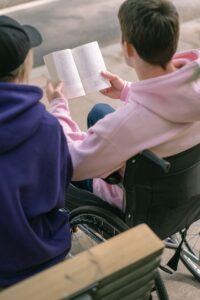
“As a school based physical therapist I work with children, school staff, administrators, and parents to help children with gross motor deficits access their educational curriculum and educational environment as independently as possible with their peers. I often collaborate with team members to assist students in maximizing their physical participation in daily routines to optimize learning outcomes. I also educate school staff on the importance of incorporating physical activity throughout the school day for health benefits as well as academic aptitude.” Amy M. Schlessman, PT, DPT, DHS, University of Findlay Assistant Professor of PT, and Apply EBP Mentor
7. Talk about our “functional” lens
“Yes! We do! OTs provide evaluation and intervention for students at school. OTs use a very functional lens to look at challenges that folks, including students, are having with doing their occupations! What they want and need to do during the course of their day, that’s an occupation. And OTs are great problem-solvers around these challenges. The next time you need some brainstorming for a student challenge, find me, and we can work together!” – Peggy Morris, OTD, OTR/L, BCP, Tufts University Senior Lecturer and Apply EBP Mentor
8. We are there throughout their schooling, from preschool to graduating high school
“We help children with disabilities from preschool all the way up to graduation participate in school. A lot of teachers, principals and administrators don’t realize that children with disabilities have equal access to education just as any other child without a disability. That’s my role-to help others understand how we can best support the children with disabilities at school. I can teach teachers how to help the child in a wheelchair access the playground or cafeteria. I can help a child learning to walk with crutches how to walk safely in her classroom or in a crowded area of school such as hallways recess. I want students with disabilities to be able to participate in recess and physical education and field trips; any and every activity the general education students do! We work directly with students when they are learning new skills and also provide consultation with teachers and families. I want the students I work with to feel confident and be able to advocate for themselves as they transition from high school to college or to a worksite or wherever they choose to be after graduation and be an active part of the community.” – Karen Tartick, PT, Durham Public Schools Therapist and Apply EBP Mentor
9. Highlight the school environments where you work
“As a physical therapist in school I work with children from preschool all the way up through high school and into post secondary school. The school physical therapist can teach the child with a disability and the school staff the best ways to help him/her access the school environment safely. We want them to be able to participate in activities with their peers and be a part of the school community. We work with teachers, bus drivers, parents, PE teachers and also we work with the students in their natural environment to safely access areas such as the school gym, bus stairs, the playground the lunchroom- anywhere where the student may need support. We teach the children with disabilities how to not only physically access school to the best of their abilities, but also how to advocate for themselves as they go through school so when they graduate they can feel confident in advocating for themselves in the community.” – Karen Tartick, PT, Durham Public Schools Therapist and Apply EBP Mentor
“Thanks for asking! Occupational therapists do work in schools, with teachers and with students. We can work indirectly through collaboration with a teacher on behalf of a student, and we can work directly with a student in their classroom, to support them and their teacher to provide the best learning environment, during math, or ELA, or music, or PE; on the playground, in the cafeteria, embedded in art class, all to support functional tasks that a student does in the course of their role, their occupation, as a student!” – Peggy Morris, OTD, OTR/L, BCP, Tufts University Senior Lecturer and Apply EBP Mentor
10. Describe how school-based therapy is different from clinic-based therapy
“School based physical therapists do not work with athletes who might have torn their ACL or sprained an ankle. PTs in the schools help students with disabilities access their education. If a student’s motor difficulty impacts their ability to learn and access the educational environment, physical therapy expertise may be required to teach the student the skill. For example, if a student who uses a wheelchair can’t participate in an evacuation drill that requires maneuvering the stairs, a physical therapist would help develop the plan and train the staff for that. Or if a student can walk, but not steadily enough to carry a lunch tray, that may be something that a PT could teach the student to do. ” – Erika Buckhouse Hanson, PT, Fargo Public School Therapist and Apply EBP Mentor
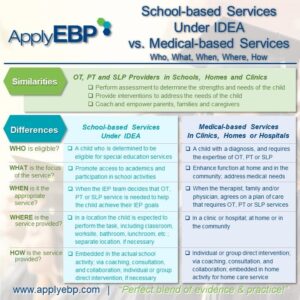
11. Shine a light on your role as part of the IEP team
“OTs and PTs have worked in the public schools since the mid-70s when the federal government mandated free education for all children. As an OT, I help students, parents, and teachers through interventions and strategies that help a student function within their daily routines as independently as possible. In the school setting, the need for therapy services is determined based on a student’s individual needs as identified by the IEP (Individualized Educational Program) team. Ideally, the team works together in addressing the student’s needs through collaborative assessment and planning, integrating strategies through their day, and making changes in the environment when it is impeding a student’s participation in activities with their peers. This job requires a lot of creative problem solving, usually with a group of amazing team members (including the student!) In some situations, I provide direct services either within or outside of the classroom. But the ultimate goal of a school-based therapist is to be a catalyst for maximizing the student’s ability to learn and engage with their same age peers to the greatest extent possible by building the student’s capacity through skill development, environmental and curricular modifications, and training other team members so that the student can spend as much of their day as possible learning and engaging with their peers.” – Carlynn Higbie, OTR, Education Consultant/Special Education Team, WI Department of Public Instruction
“Yes, PTs work in the school- we are an important part of the team as we work with the team to help students benefit from being in school and part of their school community from a safe and functional perspective …we work in the classroom and anywhere the student has a challenge engaging with peers and participating in something important like morning meeting, recess and lunch as examples. We work in the classroom and those other locations because students learn better when doing things when they occur – we will work together to identify challenges and help develop strategies to mitigate them. ” – Sue Cecere, PT, MHS, Sequoia School-based Solutions owner and Apply EBP mentor
12. Finally, have a script for those long elevator rides, or if you have time to sit down, have coffee and chat
“Providing physical therapy (PT) in our public schools is the only legally mandated PT service that is paid for by tax payers. PT, OT or Speech services are a few of the many other types of services that are related to education and provided to students through the Individuals with Disabilities Education Act for our public school systems for students in preschool until completing high school.
We work at school in a number of ways that are similar to how you may encounter PTs in other settings like hospitals or clinics. What is different is that EVERYTHING we do must be relevant to the student’s education, such as:
- evaluating student’s abilities and challenges just in the school context
- developing goals in collaboration with the student’s Individualized Educational Program (IEP) team that are needed to address educational priorities
- working with students and their peers, educational personnel as well as family members/caregivers on skills, self-determination/independence and functional performance
- measuring & documenting progress
- providing consultation for access, equipment & safety
- offering expertise to address challenges as they occur
PTs and PT Assistants (PTAs) use our expertise to help students to access school environments, engage in learning, participate in classes and school routines (like getting & eating breakfast or lunch, using the restroom, moving between classes, playing at recess, learning the physical education, health or other curriculum, taking part in extracurricular activities).
We partner with educational professionals in how to (and how not to) help students with disabilities during school routines, work and other educational opportunities.
We want each student, regardless of their abilities, health or challenges to learn, to be engaged, to do all the things they want to do at school and to contribute to their school community.
To put it in a nutshell, PTs & PTAs leverage our knowledge and creativity in public schools- in all school programs, routines and classes, throughout the school day, in all school buildings and campuses- and beyond; to ensure a student’s body does not limit them in learning, participating, working, exploring, connecting, contributing, playing and being successful as a student.” – Laurie Ray, MPT, PhD, North Carolina PT Consultant and Apply EBP Mentor

Your turn!
Now it’s your turn. Share your Elevator Speech in the comments section below or on our SeekFreaks Facebook Group Page. Have a smooth start to the school year!
More Recommendations!
Join the author, Carlo Vialu, and the school-based experts featured in this article for a School-based OT and PT Symposium of your choice…in-person or on-demand…
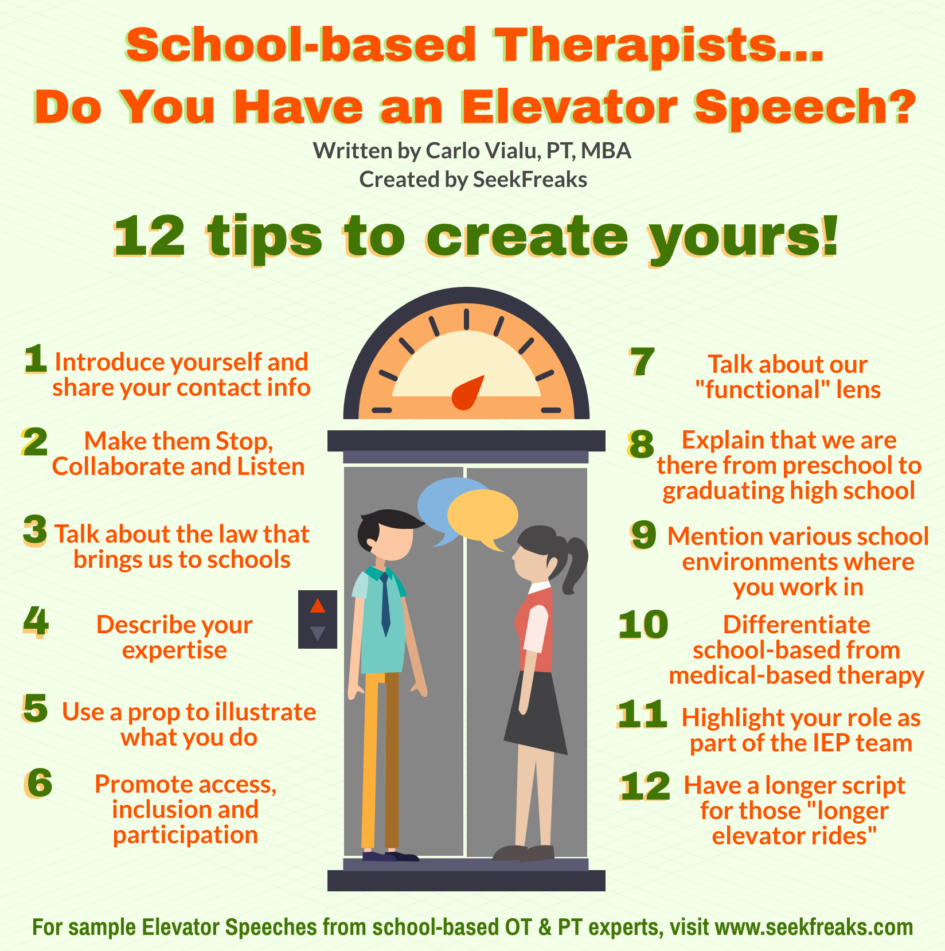
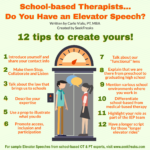






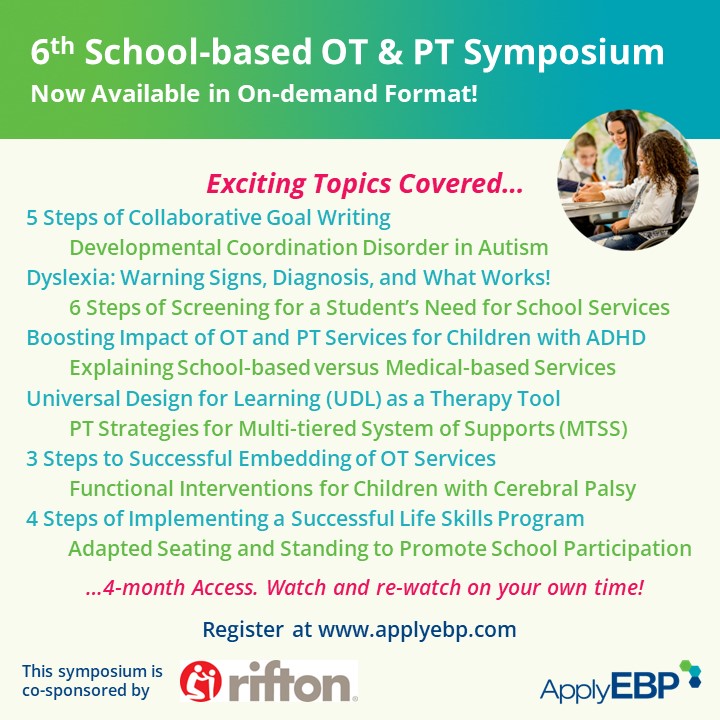
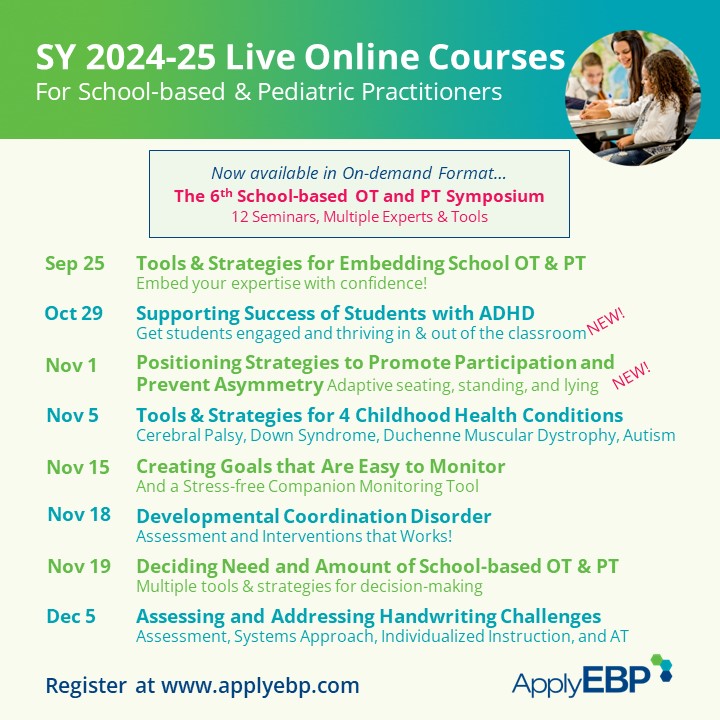
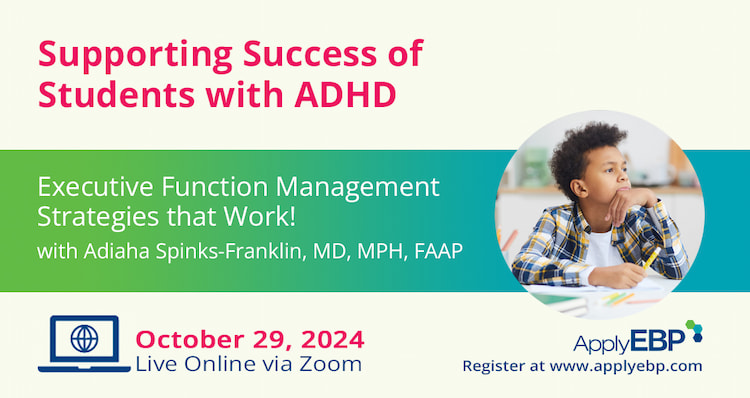
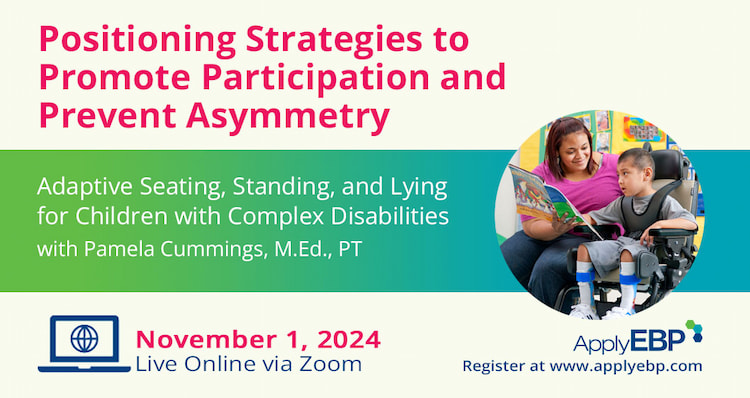








1 Pingback